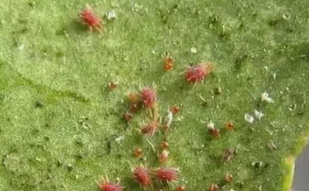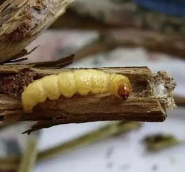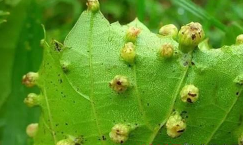
Grape pest
Grape is a kind of common fruit which is widely planted all over the world. However, in the process of cultivation, there is a wide variety of diseases and insect pests that leads to the decrease of grape yield. Therefore, the control of grape diseases and pests is particularly important.
Main insect pests
2.1 Brevipoalpus lewisi McGregor
This insect pest mainly damages the new shoots, leaves, stems and fruits of grape. Grainy bulges appear on the epidermis of damaged new shoots. Damaged leaves become yellow and fall off.. The damaged fruit stems become black while fruit make spots appear on the epidermis, and taste rough and sour.
Characteristics of occurrence:
More than 6 generations occur a year. The density of occurrence varies from varieties. The pest generally prefers variety with shorter tomentum, such as muscat grape, carignan grape and other varieties. The optimum temperature is 29℃ and humidity 80%-85%, which are most suitable for its growth and development.
Prevention and control measures
① Before cold protection, remove the bark from the vine to prevent overwintering pests in the coming year.
② Chemical control: Protective fungicides such as lime sulphur can be used for early prevention. After the disease occurs, Abamectin 1% + Spirodiclofen 19% SC can be used.

2.2 Paranthrene regalis Butler
The larvae harm grape vines, causing them to die. The larvae mostly eat the pith of the vine. After the pith is eaten, the injured part becomes swollen, which causes the leaves to turn yellow and the fruit to fall off. The eaten vines are easy to break and die. There are sticky frass outside the decaying branch.
Characteristics of occurrence: Most of the damaged branches are larger than 0.5 cm in diameter. The damaged tender branches are often swollen, and the old branches are mostly withered. In particular, the main branches are damaged, causing a large number of fruit to fall, which seriously affects the yield. Generally, larvae can transfer once or twice, mostly in July or August. They transfer frequently on the branches with weak growth potential, short internodes and thin branches. After the older larvae transfer to the new branches, they usually firstly bore a large hole under the cavity, so the damaged branches are easily snapped off and withered. The larvae often expel a large amount of dung from the cavity. After October, the larvae overwinter in the diseased branches.
Prevention and control measures
① Winter pruning is a great method.
② Chemical control: The pesticide spraying should be carried out during the critical period of spawning or larvae hatching . Generally, it should be carried out for 3 consecutive times in a cycle of 8-10 days. Pesticides such as Deltamethrin 25g/L EC, Methoxyfenozide 240g/L SC, Chlorfenapyr 240g/L SC, Emamectin benzoate 5% WG can be applied. When using it, apply accurate ratio to prevent resistance or residue harm to consumer. In addition, regular inspections are required in summer and winter to prevent large-scale pests, which can affect the yield and quality.

2.3 Phylloxera
It will not only cause harm to the grape leaves, but also threaten the roots. When the leaves are infected, a lot of granular materials will be formed on the back of the leaves; and the damage to the roots will cause the roots to be intamescentia and nodules appear. In severe cases, roots may rot or even die.
Characteristics of occurrence:
The development and reproduction of phylloxera are closely related to climate and soil factors. The conditions suitable for grape cultivation are also suitable for the occurrence and reproduction of phylloxera. Dry climate can cause rampant damage. Loose soil with agglomerated structure is suitable for the development, reproduction and activity of phylloxera while sandy soil can inhibit the pest.
Prevention and control measures
① For sporadic occurrence, resolutely eradicate phylloxera by felling grapes in combination with chemical control.
② Chemical control: Phoxim, abamectin, chloropicrin and hexachlorobutadiene can be chosen to treat soil.
